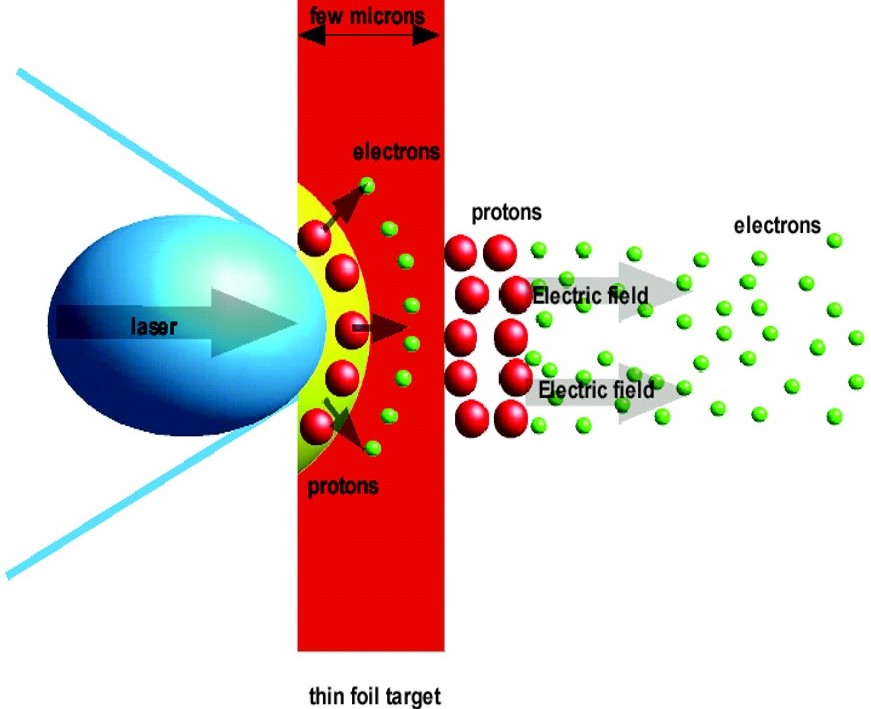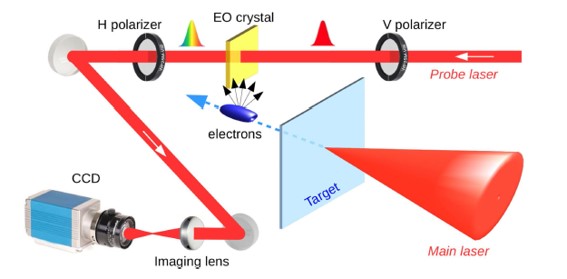
TNSA scheme
Ion acceleration from thin foils irradiated by high-intensity short-pulse lasers is one of the most interesting aspects in this research field since it produces a large amount of particles with energies in the multi-MeV range. Following theoretical models, the process starts when the electrons accelerated by the laser pass through the solid target. The majority of them spread out and dissipate energy, while only the fastest component can reach the target rear side. On this side some of the most energetic electrons escape, leaving an electrostatic potential on target, due to the unbalanced positive charge left on it. Such a potential generates an electric field that ionizes and accelerates surface ions in a process called Target Normal Sheath Acceleration (TNSA).
At FLAME, we have shown direct and temporally resolved measurements of the electric field carried by fast electrons. We have used a diagnostic based on Electro-Optical Sampling (EOS), widely utilized in conventional accelerators, with sub-picosecond resolution.

Scheme of EOS measurement
The role of the target shape in the fast electron emission has been studied, comparing planar, wedge and tip target geometries. These studies have revealed an increase in terms of charge and energy of the fast electrons, with a consequently enhancement of their electric field, using tip targets. Therefore, this result shows the possibility to boost the ion acceleration by exploiting structured targets.
Publication highlights:
- “Femtosecond dynamics of energetic electrons in high intensity laser-matter interactions”, R. Pompili et al., Sci. Rep.vol. 6 (2016) pag. 35000, doi: 10.1038/srep35000
- “Sub-picosecond snapshots of fast electrons from high intensity laser-matter interactions”, R. Pompili, et al., Opt. Express vol 24 (2016) pag. 29512, doi: 10.1364/OE.24.029512
- “Innovative single-shot diagnostics for electrons from laser wakefield acceleration at FLAME”, F. G. Bisesto et al., J. Phys.: Conf. Ser. vol. 874 (2017) pag. 012035, doi: 10.1088/1742-6596/874/1/012035
- “Evolution of the electric fields induced in high intensity laser–matter interactions”, F. G. Bisesto et al., Nucl. Instr. Meth. Phys. Res. A vol. 909 (2018) pag. 398, doi:10.1016/j.nima.2018.03.040
- “Electro-optical detection of coherent radiation induced by relativistic electron bunches in the near and far fields”, A. Curcio, et al., Phys. Rev. Applied vol. 9 (2018) pag. 024004, doi: 10.1103/PhysRevApplied.9.024004
- “Ultrafast evolution of electric fields from high-intensity laser-matter interactions”, R. Pompili, et al., Sci. Rep. vol. 8 (2018) pag. 3243, doi: 10.1038%2Fs41598-018-21711-4
- “Single-shot electrons and protons time-resolved detection from high-intensity laser-solid matter interactions at SPARC_LAB”, F. G. Bisesto, et al. High Power Laser Science and Engineering, vol. 7 (2019) pag. e53, doi: 10.1017/hpl.2019.39
- “Review on TNSA diagnostics and recent developments at SPARC_LAB”, F. G. Bisesto et al., High Power Laser Science and Engineering, vol. 7 (2019) pag. e56, doi: 10.1017/hpl.2019.41
Contact person: M. P. Anania, Maria.Pia.Anania@lnf.infn.it, tel. (+39) 069403 2947

